Knee joints are a very important part of the musculoskeletal system. Every day they have to withstand enormous loads, and given their superficial location and structural features, the risk of damage and various diseases is very high. Most often, people complain of pain in the knee joints themselves, which are caused by arthrosis or arthritis, but no less dangerous is the situation when pain begins to bother them under the knee. Such discomfort can be caused by serious reasons and significantly worsen a person’s quality of life. Therefore, let's figure out why the leg may hurt in the joint under the knee.
Why does my leg hurt under the knee?
It is very difficult to immediately determine why a person is bothered by pain under the knee, since this area of the human body is complex. There is a large number of anatomical structures, damage to each of which may be accompanied by pain. So, pain at the back of the knee may be associated with injury:
- structures of the knee joint,
- muscular frame of the knee joint,
- extra-articular ligaments,
- blood vessels,
- lymph nodes,
- nerve fibers
- fatty tissue of the popliteal fossa.
The complexity of diagnosis forces the use of examination methods such as radiography, computed tomography, magnetic resonance imaging, and ultrasound. Particularly informative is MRI, which allows you to clearly examine soft tissues and find the cause of pain.
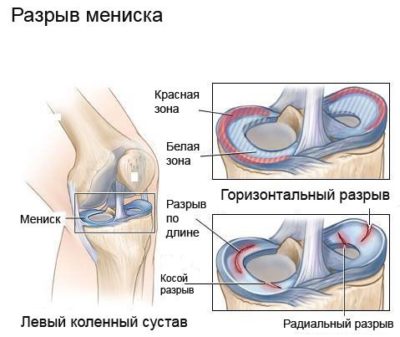
The popliteal fossa contains a large number of important anatomical structures
Causes associated with knee joint pathology
As a rule, diseases of the knee joints are accompanied by pain along the front surface of the knee, but some ailments manifest themselves as painful sensations in the popliteal fossa.
This is a benign cystic formation, which consists of a dense connective tissue membrane, and inside is filled with viscous jelly-like contents. Anatomically connected to the capsule of the knee joint, therefore it is located nearby and most often in the popliteal fossa.
Women are more often affected, but the prognosis is favorable. Education never degenerates into malignant tumor, although it can bring a lot of inconvenience to its owner. The only way to completely get rid of a Baker's cyst is through surgery. But it is important to know that the cyst often recurs, so sometimes it may take 2-3 operations or more to get rid of it.
Baker's cyst symptoms:
- the formation has a round or oval shape;
- the skin over it is not changed, the surface is smooth;
- to the touch the cyst is soft, inactive, elastic;
- as a rule, there is no pain, but sometimes a nagging pain may occur;
- located in the popliteal fossa;
- sizes vary - from invisible to 3-5 cm in diameter;
- if the cyst reaches big size, it can limit the range of motion in knee joint.
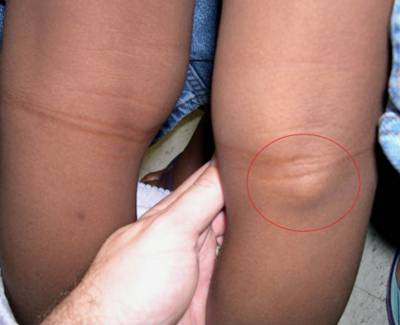
Baker's cyst, or hygroma of the popliteal fossa
Knee meniscus cyst
This is a fluid-filled formation in the thickness of the cartilage tissue of the menisci of the knee joints. This pathology often affects young and active people, athletes. Its cause is considered to be increased loads on the cartilaginous intra-articular tissue.
The main symptom of the disease is pain that occurs along the lateral surface of the knees and behind. Pain occurs when moving the knees and is absent at rest. In some cases, slight swelling may be noted in this area.
If treatment is not started, a meniscus cyst can cause secondary deforming arthrosis of the knee joint. The only way to completely get rid of the tumor is through surgery.
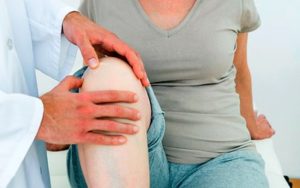
Knee meniscus injuries
If you have pain under the knee and it started after some kind of injury, then you need to think about damage to the back of the lateral or medial meniscus of the knee. Also, meniscal rupture can occur due to inflammatory or degenerative processes. Treatment for such an injury is only surgical.
Diseases of periarticular soft tissues
Pain at the back of the knee can be associated with inflammation, strain, or damage to the muscles, ligaments, and bursae of the popliteal fossa. For example, the ligaments behind the knee often hurt after a long walk, heavy physical labor, or standing on your feet for a long time.
Tendinitis and bursitis, which are caused by aseptic or infectious inflammation, can develop in this area. In this case, a sharp or nagging pain occurs, which appears or intensifies with exertion. If the inflammation is purulent, then redness of the skin under the knee appears, it becomes hot to the touch, swelling forms, and the function of the joint is impaired. Symptoms of general malaise, such as fever, may also occur.
Treatment for knee pain of this nature is usually conservative. First you need to provide complete rest to the sore leg. For this purpose, special orthoses can be used. Anti-inflammatory and analgesic therapy is prescribed, and for infectious inflammation - antibiotics. After the elimination of acute inflammation, therapeutic exercises and physiotherapy begin. The prognosis for tendinitis and bursitis of the knee is favorable.

Several tendons are attached to the knee joint, which, when inflamed or stretched, are accompanied by pain
When an infection gets into the popliteal area, purulent inflammation of the fatty tissue may occur. They can also be involved in the pathological process The lymph nodes. In such a situation, painful enlarged lymph nodes can be felt under the knee. The skin over them turns red and swelling develops. Treatment is conservative, with anti-inflammatory and antibacterial therapy. In case of ineffectiveness, surgical sanitation of the purulent focus begins.
Vascular diseases
The popliteal artery and vein pass deep into the popliteal fossa. Accordingly, pain may be due to damage to one of these anatomical structures. Most often the reason painful sensations under the knee of a vascular nature are:
Phlebeurysm
Stagnation of venous blood due to incompetent vein valves is often accompanied by pain in the legs. It usually appears below the knee and goes down to the shin. The pain is aching and appears in the evening or after standing for a long time. Accompanied by swelling of the lower extremities. With superficial varicose veins, you can consider dilated venous nodes under the skin or a vascular network, the favorite location of which is the popliteal fossa. In case of deep vein varicose veins external signs there may not be.
Thrombosis of the popliteal vein
This is a fairly rare pathology that can occur with inflammation of a vein (thrombophlebitis), with a blood clotting disorder (thrombophyllia) or occur as a complication of varicose veins. With thrombosis, patients complain of intense pain in the popliteal region. Over the course of several hours, the leg becomes dark cherry or bluish and hot to the touch. It swells greatly, sometimes increasing 2 or more times in diameter.
Treatment can be either conservative (administration of anticoagulants, antibiotics) or surgical. If therapy is not started in time, the patient may be left without a leg due to the development of gangrene.
Blocking the lumen of an arterial vessel with emboli is not so rare. According to the localization of thromboembolism, damage to the lower extremities is in 4th place after the coronary, cerebral arteries and aorta. The cause is mainly embologenic heart diseases (rheumatism, septic endocarditis, atrial fibrillation and other types of arrhythmias, heart defects, artificial heart valves).
In the case of popliteal artery embolism, sharp and very intense pain occurs. The leg becomes pale and cold to the touch. It is not possible to feel the pulse in the arteries of the foot. If help is not provided within 2-3 hours, gangrene develops, which requires amputation of the limb. Treatment is mainly surgical.
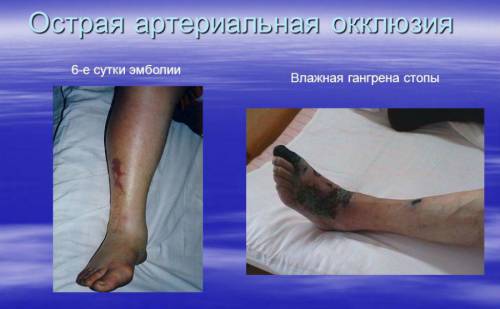
Embolism of the popliteal artery and its consequences
Popliteal artery aneurysm
This is a protrusion of the artery wall to the side. It can be either a congenital defect or acquired as a result of damage to the arterial wall, for example, an atherosclerotic process. If an aneurysm is present, then in the popliteal fossa you can feel a soft and elastic formation that pulsates. Pain occurs when the aneurysm reaches large sizes, which puts pressure on surrounding nerves and other structures.
If an aneurysm is found, it must be removed surgically. Otherwise, it can rupture at any time and cause extensive and fatal bleeding.
Nerve damage
The tibial nerve runs along the bottom of the popliteal fossa, damage to which can be accompanied by pain in this area. Main nerve diseases:
- tumor (neurinoma),
- trauma (bruise, pinching, sprain, rupture),
- inflammation.
In addition to pain, when the tibial nerve is damaged, there is a violation of the sensitivity of the skin of the leg and foot, decreased tendon reflexes, paresis of the foot, decreased muscle strength and atrophy of the lower leg muscles. Treatment depends on the cause.
Thus, pain under the knee can be caused by more than a dozen reasons. In each case, determining the etiology of pain is very important, since the treatment and its success directly depend on this.
Pain in the knee joint occurs in inflammatory and degenerative diseases – arthritis and arthrosis. No less often, discomfort occurs under the knee, which is usually associated with other causes of the pathological process. The popliteal fossa is limited above and below by the ligamentous apparatus, as well as by the muscles of the thigh and lower leg. Its bottom is represented by the posterior surface of the femur and the articular capsule of the knee. The area behind the knee joint is filled with adipose tissue, in the thickness of which passes the femoral nerve, artery and vein, united in a neurovascular bundle. The popliteal fossa contains lymph nodes - a protective barrier against ascending infection from the lower leg and foot area. Pain behind the knee due to injury and inflammation of the above mentioned formations.
Cyst and meniscus tear
The cause of pain in the popliteal fossa when walking can be a cyst of the meniscus, a cartilage that performs a shock-absorbing function during movement. A cystic formation appears in the posterior horns, located near the external (lateral) and internal (medial) collateral ligaments. Even small cysts that are not detected by external examination and palpation (feeling) cause severe pain. Most common cause pathology is considered a violation metabolic processes cartilage tissue or chronic injury during intense physical activity, including during sports.
A tear of the posterior horn of the meniscus usually occurs in the area of the medial collateral ligament and is associated with unnatural forced rotation of the tibia. This causes intense pain, impaired movement and a feeling of “buckling” in the knee joint. If the pathology progresses, knee blockade may appear - the inability to flex and extend when walking. Immobilization (immobilization) of the limb, the use of anti-inflammatory drugs (nimesulide, diclofenac, indomethacin), chonroprotectors (rumalon, teralex) help restore the affected anatomical structures. IN severe cases surgery is prescribed.
Baker's cyst
Baker's cyst most often appears in patients over 40 years of age and has a symmetrical location on both legs. The cause of the pathology is inflammation of the synovial bursa of the knee joint (synovitis); the disease develops against the background of chronic arthritis or arthrosis. In this case, a large amount of synovial fluid accumulates in the joint cavity, which, according to the principle of least resistance, penetrates into the popliteal fossa through a weak spot in the posterior wall of the knee capsule.
The disease causes swelling at the back of the knee joint, which is better visualized when the lower limb is extended. A characteristic symptom is a decrease in formation when pressure is applied to it as a result of the reverse flow of fluid into the joint cavity. The cyst causes bursting pain under the knee at rest; when walking, it pulls in this area and interferes with the normal extension of the limb. Treatment of the disease is carried out with non-steroidal drugs, hormonal drugs, including by injection into the cavity of the knee joint (hydrocartisone), and physiotherapy (ultrasound, electrophoresis with dimexide).
Purulent inflammation in the popliteal fossa
Pain syndrome at the back of the knee, wounds in the feet and legs indicate inflammation of the lymph nodes located deep in the popliteal fossa. The causes of purulent inflammation lie in the hyperactivity of pathogenic microflora against the background of insufficient functional activity of the immune system. Under such conditions, lymphadenitis and purulent melting of the popliteal lymph nodes develop, which causes discomfort when walking.
A slight swelling appears in the affected area, which is usually not accompanied by redness of the skin and an increase in local temperature. Severe pain appears with maximum extension of the limb and pressure behind the knee. If pus accumulates, surgical treatment is prescribed, antibiotic therapy is used, and physiotherapy is used at the stage of subsidence of the inflammatory process.
Damage to the neurovascular bundle
 Inflammation or tumor process of the tibial nerve causes severe pain under the knee, regardless of movement, which spreads to the foot and toes. In this case, there may be a violation of the sensitivity of the skin below the level of the lesion, a decrease in muscle tone and the extinction of tendon reflexes. Therapy of the pathological process is carried out surgically; after surgery, painkillers (nalgesin, airtal) and antibiotics are prescribed.
Inflammation or tumor process of the tibial nerve causes severe pain under the knee, regardless of movement, which spreads to the foot and toes. In this case, there may be a violation of the sensitivity of the skin below the level of the lesion, a decrease in muscle tone and the extinction of tendon reflexes. Therapy of the pathological process is carried out surgically; after surgery, painkillers (nalgesin, airtal) and antibiotics are prescribed.
Popliteal vein thrombosis is extremely rare and is a type of pathological thrombus formation in the deep veins of the leg. Disease for a long time may be asymptomatic and cause life-threatening conditions such as thromboembolism of the pulmonary artery system. Nagging pain in the popliteal region, swelling of the feet and legs, and trophic disorders appear in the later stages of the development of the pathology. The causes of thrombosis in most cases are varicose veins of the lower extremities. For treatment, antiplatelet agents (Curantil), anticoagulants (Warfarin), venotonics (Detralex), and surgical therapy are used.
An aneurysm of the popliteal artery is a dissection of its wall with the formation of a saccular protrusion. In the area of the pathological process, the vascular wall becomes thinner, becomes fragile, and can cause heavy bleeding with minor injury or physical exertion. The causes of an aneurysm are associated with a congenital defect of the artery or acquired pathology (atherosclerosis, endarteritis). The disease causes intense pain, with pulling in the area of the knee fossa while walking. The symptoms are similar to Baker's cyst; the main difference is the persistence of swelling when pressed and pulsation at the site of the artery lesion. Treatment is carried out surgically.
Disease of the periarticular tissues
The periarticular tissues of the knee joint are represented by ligaments, tendons, and tendon bursae. The cause of pain under the knee is inflammation and microtraumatization of these anatomical structures during physical overexertion or, conversely, prolonged static posture. Tendonitis, tendovaginitis, and bursitis occur when ligaments and tendons swell during intense exercise, which leads to pinching and damage. Pain in the outer part of the popliteal fossa is associated with damage to the tendon bursa of the biceps femoris muscle, and discomfort on its inner side is associated with bursitis of the semimembranosus muscle.
The pain syndrome intensifies when walking and decreases at rest, is characterized by nagging pain of moderate intensity and a one-sided pathological process. A compaction appears in the area of inflammation, which does not disappear upon palpation (feeling). Prescribe immobilization of the affected knee joint, reducing physical activity, anti-inflammatory treatment, physiotherapy.
Pain behind the knee can occur for various reasons when certain anatomical structures of the popliteal fossa are affected. To prescribe the correct treatment, you must consult a doctor and undergo a comprehensive examination to make the correct diagnosis.
Some people feel pain behind the knee when bending. The most important thing is to establish the cause of the discomfort and prescribe the correct treatment. Only in this way is it possible to completely get rid of the problem and live a full life.
Causes
There are a huge number of ligaments, blood vessels and other types of soft and bone tissue. Often the problem is associated with injuries. But the injuries received are not always the reasons why pain and discomfort is felt in the back of the knee. To accurately establish the cause, it is necessary to undergo diagnostic procedures that will answer the question of what caused the disease.
One of the most common causes of problems is a pinched sciatic nerve. Many incompetent specialists too often make this diagnosis and prescribe treatment that does not bring the desired effect. And only after thorough research has been carried out, can the causes be established, which include injuries suffered, associated with the appearance of neoplasms, and inflammation.
An equally common cause is also a problem with the meniscus. From this problem to Lately Not only professional athletes and people who regularly undergo severe physical activity suffer.
 Baker's cyst
Baker's cyst
A tumor appears characteristic nagging pain.
Causes of the disease:
- inflammatory processes;
- synovitis;
- osteoarthritis.
With this disease, excess fluid is formed, which comes out under pressure.
With this disease, the swelling is located in the very center of the popliteal fossa. It is quite common to have swelling on both limbs. It can be easily seen if the knee is straightened and disappears when the joint is bent. The cyst shrinks if you press on it, as some of the fluid goes into the joint. Most effective means Treatment of the disease includes medications, procedures, or surgery if medications do not help.
Meniscal cyst
The cyst may not even be visible during examination, but it causes enormous trouble. If such a formation is detected, there is severe pain, you may not even need to conduct additional examinations.
The causes of pathologies are injuries received during heavy physical exertion, intense sports, and also if optimal processes in cartilage are disrupted.
Meniscus tears
The problem can appear anywhere. There is an opinion that the problem can only be eliminated with the help of surgical interventions, but this is far from the case. Solve the problem of medicines and even folk remedies can. Treatment consists not only of surgical intervention, but also conservative treatment. You will need the help of several specialists at once, each of whom will do their own job. Only in this way is it possible to completely get rid of the problem and maintain a person’s full working capacity.
It most often appears if the shin is forcibly rotated, and is characteristic specifically of the internal meniscus. As a rule, when the posterior horn of the meniscus is torn, the knee joint does not become blocked, but the problem of the so-called “buckling” of the joint may arise if the damaged horn of the meniscus has shifted.
This disease can occur both after an injury and in diseases that lead to disturbances in the nutritional processes of cartilage tissue. And subsequently the cartilage began to deteriorate.
Meniscus tear can only be cured with surgery. Quite often it is also required drug treatment, which is prescribed for inflammatory processes. It is necessary to limit the limb's movements by applying an elastic bandage and wearing a knee brace. The irritating factor must be eliminated. Sometimes such measures can avoid surgery and eliminate leg pain in the knee and calf area.
Tendon inflammation
In this area of the body contains a lot of tendons. A sign that not everything is all right with them may be a decrease in tone. To eliminate this unpleasant phenomenon, a qualified specialist and the correct course of treatment are required. There are several reasons that lead to disorders in the soft tissues near the knee joint:
- one of the main reasons is strong physical activity, which is accompanied by the same type of movements over a fairly long period of time, a long stay in one position;
- suffered trauma, even the most minor one, can lead to problems with soft tissues near the knee, which leads to the appearance of inflammatory processes that can cause serious complications and discomfort;
- bursitis;
- tendinitis;
- Tenosynovitis.
The last three diseases develop after injury and physical activity, if the necessary measures are not taken.
In the back of the knee joint, in the area of soft tissue, inflammatory processes can develop - bursitis. With this disease, the tendons become more compacted - this can be felt by palpation. The difference from a Baker's cyst is that when pressure is applied, the lumps and tumors do not become smaller in size, since they are not connected to the capsule of the knee joints.
Bursitis and tendovaginitis manifest themselves not only in the tightening of the tendons, but also in the fact that pain appears at the back of the knee joint. People of all ages and both sexes are at risk. Most patients claim that before the onset of pain there was heavy physical activity. And only then did nagging pains appear.
To successfully cure diseases, you need to ensure complete rest for the joint. You need to bend and straighten your leg as little as possible. If the pain becomes severe and the leg cannot be rested, it is necessary to wear a knee brace, or a plaster splint may be applied. In parallel, drug treatment is carried out using drugs for inflammation. This treatment is very similar to the course of any diseases associated with joint diseases. Procedures are prescribed to improve the effect.
Be that as it may, the disease is quite serious and requires close attention. Otherwise, irreversible processes and complications may begin that will have a negative effect on the entire musculoskeletal system.
Diseases caused by inflammatory processes
There are even diseases that can cause an abscess. Such diseases are usually associated with inflammation in the body. If you have pain in the back of your knee, and also have an infected wound on your leg, an inflammatory process in the knee area may begin with the flow of lymph. The lymph nodes are hidden deeply, it is very difficult to determine their increase in size by palpation, a slight swelling visually appears if you press on it - the pain intensifies significantly.
This pathology does not have pronounced symptoms, which are characteristic of inflammatory processes in the human body. The lymph nodes are deep, so it is very difficult to determine their enlargement. There is slight swelling under the knee.
If you press on it while the joint is extended, the pain becomes very severe. This is the main symptom that indicates the presence of this disease.
Diseases of blood vessels and nerves
There are several diseases that cause dysfunction of blood vessels and nerves, which subsequently causes pain behind the knee.
- A tumor may form on the tibial nerve, which leads to severe pain in the area under the knee and behind. Pain can be felt all the way to the foot. In addition, changes in muscle and tendon tone are characteristic. The problem must be taken seriously; comprehensive treatment is the most effective. There are folk remedies, but they may not cause a positive effect. You only need to treat with surgery, and then go through a rehabilitation process with the help of medications and procedures. Painkillers are prescribed before surgery to reduce suffering. Official science cannot answer why this disease appears.
- Diseases associated with the blood vessels that pass through this area of the human body can create huge problems. As a rule, with vascular disease, severe pain is not felt, but with the slightest injury severe bleeding may occur. One of the most common problems is arterial dissection. It can only be established using modern diagnostic equipment and certain symptoms.
- Quite rarely, blood clots can occur in the popliteal vein. but when they appear, it may occur serious illness– popliteal vein thrombosis. The danger also lies in the fact that the symptoms of the disease are practically absent and appear only when complications begin. If the diagnosis is incorrect, a diagnosis of sciatic nerve entrapment may be made.
To establish exactly what kind of disease we are dealing with, it is necessary to conduct an ultrasound of the blood vessels and some other diagnostic measures.
Diagnosis should be carried out not only when sensations of pain or discomfort appear, but also for the purpose of prevention.
Thrombosis, depending on the nature and stage of the disease, can be treated with medication or surgery.
You cannot treat diseases that cause pain behind the knee on your own. This should be done by specialists.
conclusions
Almost every disease that causes pain or discomfort in the back of the knee requires specialist intervention. There are also traditional methods treatment, but not every method traditional medicine capable of producing the expected effect. This is due to the fact that many diseases require surgical intervention, painkillers, and anti-inflammatory drugs.
Before starting treatment, you need to contact an experienced specialist, and in some cases it is necessary to combine the efforts of several doctors at once, using drugs and complex treatment procedures.
Watch a video about endemic massage, which can help in many cases
In contact with
One of the most common complaints people have is pain in the back. There can be many reasons, because the heaviest load falls on the knees.
Content:
Causes of pain
Sometimes a person feels pain behind the knee, in both legs. Most often, this phenomenon is associated with muscle overload, especially after training.
An unpleasant sensation appears only the next day after classes. And reaches its peak every other day. But this is the most harmless reason why there may be pain behind the knee.
If we talk about more serious reasons that can provoke severe pain, these include:
- Trauma. Those people who constantly play sports, and do not limit themselves to physical activity, often have pain in their knees due to the fact that even more stress is placed on them. As a rule, constant long-term stress, especially in overweight people, can cause inflammation of the periarticular bursa. In addition, as a result of awkward movement, the injury can stretch or tear the tendon, which is also very dangerous and causes severe pain.
- Joint damage, which can happen to anyone, at any time. Quite often, knee joint behavior occurs not only in athletes, but also in ordinary people during the imin period of time, especially during icy conditions. First of all, when slipping, a person lands on his knees, and if the impact was strong, then due to calcium deficiency or other existing injuries, the joint may also suffer
- Nerve inflammation. If a person has an inflamed nerve, this will be accompanied not only by severe but also unbearable pain, which is quite difficult to relieve.
- Diseases in which an aneurysm can form, pressing on the nerves. And besides, the danger of an aneurysm is that it can rupture at any moment
- Inflammation of the lymph nodes, or as it is scientifically called, lymphadenitis. With lymphadenitis, the nodes become inflamed and cause pain, and it constrains the muscles. And if you try to somehow rub your knee, it will only get worse. The main thing is to determine the source of infection, which is why the nodes become inflamed
The causes of pain in the knee joint are many, but the main problem The problem is that doctors are not always able to determine it accurately and begin treatment quickly. This can often take more than two weeks.
Diseases accompanied by pain
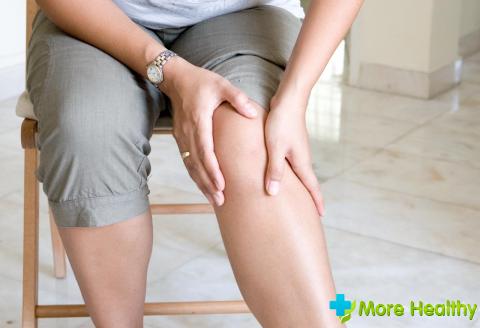
And if more general causes of pain in the knee joint were described above, then it is necessary to dwell in more detail on the diseases that provoke sharp and severe pain. The main diseases include:
- Baker's cyst, in which the synovium becomes inflamed
- meniscus, in which a sac of fluid appears in the knee, interfering with normal walking
- Meniscus tears, during which the pain can be unbearable
- Wounds with infections
- Diseases of the nerves and blood vessels of the popliteal fossa
Depending on what caused the pain, further treatment will depend, which should take place exclusively under the guidance of a specialist. Under no circumstances should you self-medicate, because this can only lead to aggravation of the problem.
Baker's cyst
Baker's cyst is one of the most common causes of pain at the back of the knee. Most often, this diagnosis is made to people over 40 years of age who have experienced heavy loads on their legs throughout their lives, that is, they have been engaged in athletics, walked a lot, etc.
The pain occurs due to the fact that the synovial membrane becomes inflamed.
The main causes of Baker's disease include:
- Knee injury. This can be either an injury to the joint itself or to the meniscus, resulting in an inflammatory process.
- Rheumatoid, which often provokes other diseases
- Gonarthrosis, when cartilage tissue is destroyed, and deformation of the joint itself also occurs
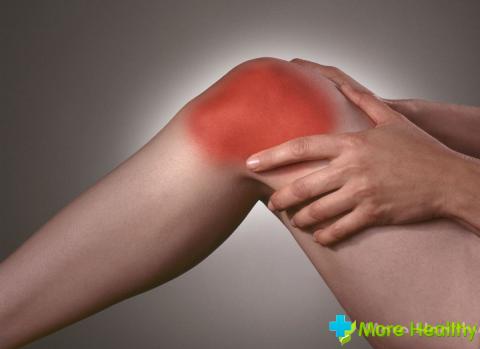
Due to the fact that all of the above diseases are accompanied by an inflammatory process, and often with the formation of fluid, the synovial membrane breaks through at the weakest point, and therefore a cyst forms.
As the cyst grows and begins to put pressure on the nerve endings, symptoms will occur. At the very beginning, a person will simply feel a slight squeeze, which will not cause much discomfort. But then = pain will appear, which will be accompanied by several more symptoms:
- Numbness and slight tingling in the foot area. Not everyone associates this phenomenon with the knee, because they believe that if there is a problem there, then the symptoms will all appear in the knee. But in fact, nerves and blood vessels are interconnected, and most often this is how a cyst manifests itself
- Difficulty bending your toes. This happens because the cyst puts pressure on the nerve endings and nerve impulses no longer arrive as before.
- Swelling under the knee joint, which may also be accompanied by a small tumor. If you press on this area, the pain will be severe
- Basically, the diagnosis of “Baker's cyst” is made at the very late stage, when fluid, as a result of a severe inflammatory process, is produced even more and accumulates in the bag, which causes it. At an early stage, a cyst may be discovered by chance.
- As for treatment, it depends on how long ago the cyst formed. If this happened recently, and the symptoms have just appeared, then conservative treatment can have a positive effect. To do this, they first take a puncture, during which the accumulated fluid is pumped out and an anti-inflammatory drug is pumped in (mostly corticosteroids). After this, the knee joint is tightly wrapped with an elastic band to reduce its mobility. In parallel with this, doctors need to find out the cause of the inflammatory process in the synovium and begin to treat the cause itself so that the problem does not return in the future.

If the patient comes with an advanced case, then an operation will be performed, during which the cyst will be removed.
Meniscal cyst
Another very common cause of pain behind the knee is a meniscal cyst, during which a cavity filled with fluid appears. This formation is directly located in the area of the meniscus itself.
Posterior pain appeared when a cyst formed on the posterior horns of the meniscus. As a rule, a meniscal cyst cannot be seen visually, and additional examination is necessary to make a diagnosis.
The main reasons for the appearance of meniscus cysts include, which over time will make themselves felt in this way, as well as poor nutrition of the knee cartilage, which is already associated with impaired blood circulation in this area.

All symptoms that will appear when a meniscus cyst forms can be divided into 3 stages:
- First stage. As the cyst grows, pain and a feeling of heaviness will appear while walking. Moreover, the pain will be tolerable and will not cause much discomfort to the person.
- Second stage. The cyst gradually enlarges and a slight swelling appears, which causes pain. But the interesting thing is that when the joint is extended, it disappears
- Third stage. The pressure becomes more and more, so the patient begins to suffer severe pain, especially while driving
It is easy to diagnose a cyst in the third stage because it becomes visible with naked gas. If we talk about earlier stages, then it will be necessary to carry out the following diagnostic procedures:
- knee joint, during which it will be seen whether there is any formation or whether it is absent
- Computed tomography, which will show the exact location and size of the cyst formed
- Arthroradiography
- MRI of the joint for a more accurate diagnosis
After the doctor has received all the results of the studies, he will be able to make an accurate diagnosis and prescribe correct and effective treatment. 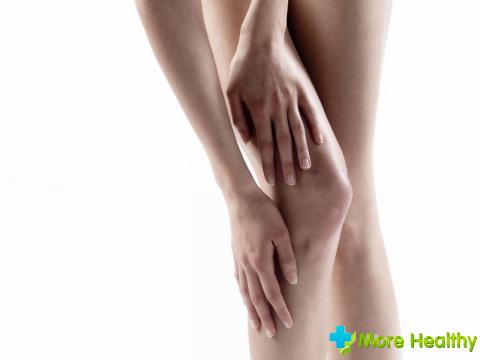
As for treatment, there are three methods:
- First method. Medication, during which the main emphasis is on medications, reducing inflammation and reducing pain. Usually, drug treatment is prescribed either before surgery or after it.
- Second method. Physiotherapy, which is carried out when the stage of remission has begun and the positive effect of treatment needs to be consolidated. In addition, with the help of rays you can reduce pain and relieve swelling
- Third method. Operation. Today, doctors can simply pump out the fluid from the cyst, but this method is temporary, and it will appear again. Or you can remove it completely by running surgery on my knee
If the meniscal cyst was detected in time, the recovery period will not be long.
Soft tissue diseases
Pain in the back of the knee can cause inflammation in the tissues that surround the knee joint itself. These include ligaments, tendons, muscles and tendon bursae.
Soft tissues are greatly strained when a person runs, jumps, etc. Particularly strong stress occurs when the loads are systematic and quite serious. Due to the fact that redness and pain may occur.
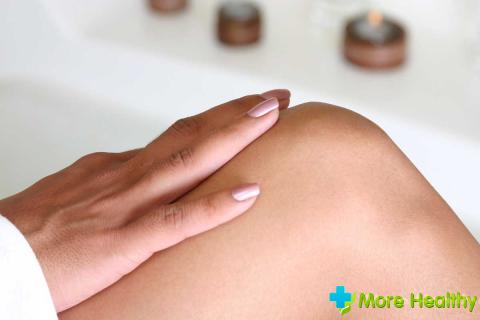
A person does not always control the load that falls on his knee joints, this is especially true among professional athletes, for whom there are certain standards. At the moment when the tissues become inflamed, they literally pinch themselves, putting pressure on the nerve endings. As a result, the next day after a heavy load a person will feel pain.
Since the main cause of inflammation of the soft tissues is heavy loads, in order to get rid of this, you need to provide complete rest to the leg, namely, apply a bandage that limits both flexion and extension of the knee joint. If the pain is severe, painkillers and anti-inflammatory drugs may be prescribed to bring the tissues to their usual and normal state as quickly as possible.
Infectious diseases of the popliteal fossa
If the knee hurts in the back and the patient discovers a wound in the area of the leg or foot, then this may indicate the occurrence of an abscess of the popliteal fossa, which manifests itself in this way. This happens because it is in the popliteal fossa that there is large cluster lymphoid tissue, as well as lymph nodes, which, as is known, are the first to respond to the penetration of any infection, increasing in size. Regional lymph nodes collect all the lymph from those located on the lower extremities.
Therefore, if a wound appears on the leg below the knee and becomes infected, then the lymph nodes will certainly react and increase in size. As a rule, with a serious inflammatory process, they can hurt and even fester.
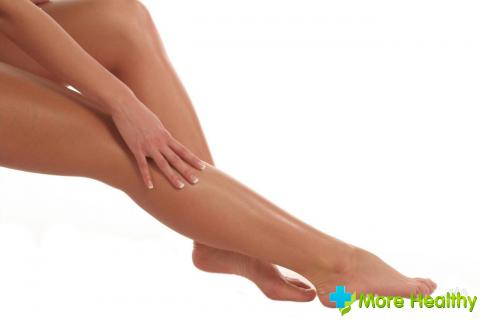
Most people, when such symptoms appear, may not consult a doctor for a long time for one reason only. Everyone is accustomed to the fact that if the lymph nodes are severely inflamed or enlarged, then the tissues are nearby. But in that case, this will not happen because they are located not on the surface, but deep.
If an abscess is discovered by a doctor, it can only be treated surgically, namely by opening the abscess and draining it.
Diseases of nerves and blood vessels
It just so happens that the majority of the world’s inhabitants believe that problems with blood vessels and nerves in this area cannot arise. This is a big mistake. There are a number of diseases during the development of which a person will feel pain in the back of the knee:
- Tumor of the tibial nerve, which causes sharp pain behind the knee. Moreover, the pain spreads all the way to the foot, making it unbearable. It can only be treated surgically, followed by the prescription of anti-inflammatory drugs to avoid suppuration.
- Aneurysm of the artery below the knee. It is very similar to a Baker's cyst, only it differs in that it pulsates when palpated. It can only be treated surgically, since it can rupture when treated with drugs. spine .
Prevention of knee diseases
In order to keep your knee joints as long as possible good condition, heavy physical exertion should be avoided. Not all people understand this and attach importance to the recommendations of specialists when isolated cases of pain occur. And most often, after the pain goes away, they go in for sports again without waiting for a full recovery.
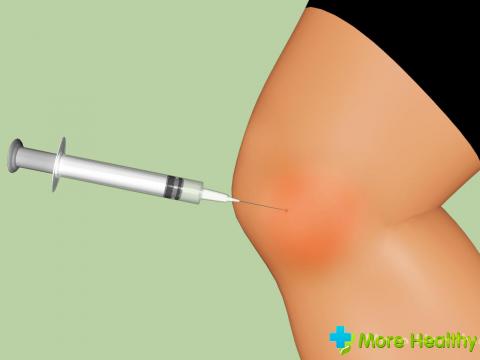
In addition, to keep your joints and bones strong, you need to eat foods that contain a lot of calcium, because it is actively consumed during sports.
Most doctors note that if the patient fully follows all the recommendations, follows the regimen and avoids stress, then he will be able to recover from the disease much faster, and subsequent relapses will be excluded.
While watching the video you will learn about knee pain.
Sharp pain under the back is a very serious symptom that should not be ignored because the earlier the problem was identified, the faster and safer it can be eliminated. The main thing is not to self-medicate or resort to folk remedies without consulting your doctor.
Pain in the head, in the lower abdomen in women, or in the stomach after poor-quality food is considered common and understandable for people. If there is pain behind the knee, what could it be?
With such a symptom, it is recommended to pay attention to your health and find out the cause of the pathology, which can cause a person both mild discomfort and unbearable pain. About 15% of people suffer from knee joint diseases, but few know that it is necessary to treat such conditions.
The popliteal cavity is surrounded above and below by the knee tendon, as well as muscles extending from the thigh and lower leg. At the bottom is the femur, and in the middle are the knee nerve, artery and vein. The free space is filled with subcutaneous fat. Don’t forget about the lymph nodes, which serve as a barrier against infection in the foot and leg area.
Such a complex structure makes it difficult to diagnose diseases.
In addition, the nerves in the popliteal fossa can also transmit pain from the lower parts of the spine.
Causes
What can cause pain behind the knee? In most cases, it is difficult to independently determine the cause and this will require consultation with a doctor and additional diagnostic methods.
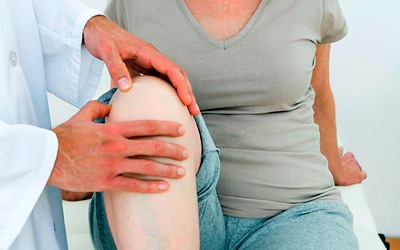
A possible cause of pain under the left or right knee may be hidden in:
- Pathologies of the knee joint itself;
- Periarticular inflammatory and infectious processes;
- Conditions not related to the musculoskeletal system.
Provoking factors
Why do some people develop joint problems very early, while others lead an active lifestyle until old age?
There are several categories of people predisposed to bone or connective tissue diseases:
- Professional athletes. Joints and sprains are a big problem for such people. Their joints endure not only heavy loads, but also excessive activity, which leads to premature wear. The athlete's muscle often cramps and twitches. According to statistics, the left leg is less often affected;
- Workers with heavy physical labor. Heavy stress destroys joints and accelerates the pathological process. If a problem appears and the cause is not eliminated, this can lead to disability;
- People after operations or infectious diseases . Pulling pain in the area of the popliteal fossa may appear as a result of innervation of nerve endings from other foci of inflammation.
Joint diseases
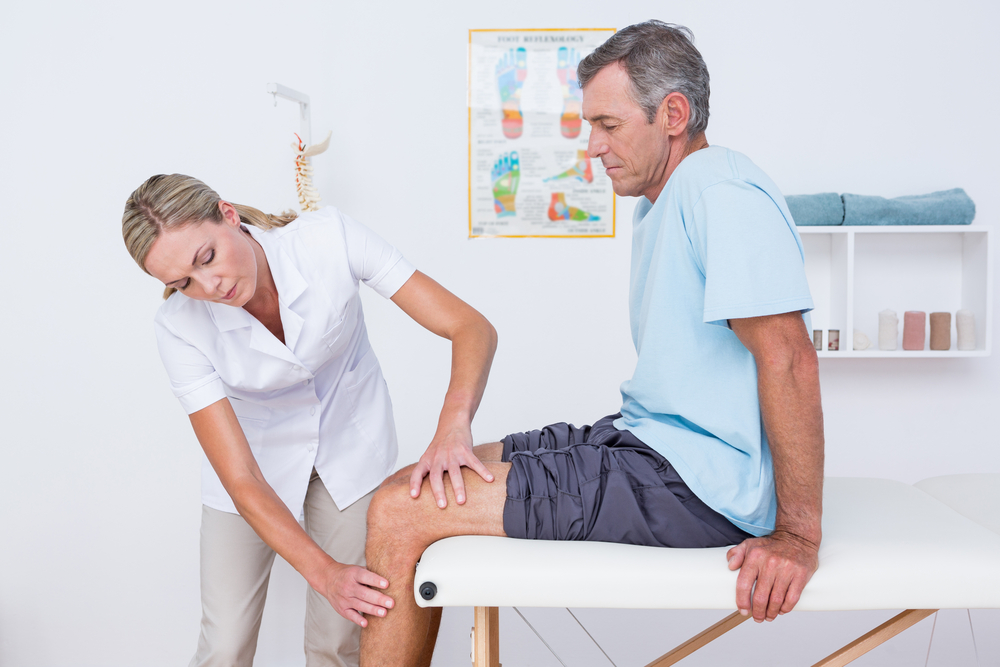 If the knee is inflamed, pain will occur when bending and straightening the knee.
If the knee is inflamed, pain will occur when bending and straightening the knee. Pain under the kneecap can occur as a result of:
- Cystic formations. A well-known disease, Baker's cyst, most often affects women after 35 years of age. The disease occurs as a result of pre-existing arthrosis and osteoporosis, representing a chronic inflammatory process in the synovium. Cystic lesions of the menisci are also possible;
- Meniscus injuries. A rupture often occurs after excessive stress on the joint. This condition requires immediate medical care, otherwise the injury will lead to disability.
Periarticular pathologies
If tendons, ligaments, muscles, or joint capsules are inflamed or mechanically damaged, you may feel that the popliteal fossa hurts. If the back of the joint is inflamed, we can assume the presence of bursitis, in which the seal does not disappear when pressed, and the pain may radiate to the surface of the thigh.
Non-orthopedic diseases
The following may contribute to the appearance of pain under the knee:
- Neoplasms, mainly tumors of nerve endings. In this case, severe aching or sharp pain in the back of the knee it is also duplicated in the calf;
- Lesions of blood structures, for example, an aneurysm of the popliteal artery or vein thrombosis (one of the complications of varicose veins, when the vein swells and a blood clot forms in it). It may be noticeable that the affected area is swollen and throbbing, or a bruise appears without a contusion;
- Infected wounds below the joint can lead to purulent diseases left or right popliteal fossa. In this case, there is inflammation of the lymph nodes and increased pain when bending the leg.
Symptoms
Popliteal pain can be of different types, for example:
- With Baker's cyst An adult is bothered by nagging, not severe pain. As a rule, one leg aches. The cyst, or hernia, is noticeable even externally - it looks like a swelling that is located in the middle of the popliteal fossa. If the patient notices that he is swollen in this place, it means that there is an accumulation of excess liquid, which moves into the cup when pressed;
- Meniscal cyst lesion, on the contrary, is characterized by severe and sharp pain;
- Damage to periarticular structures manifests itself as pain of moderate intensity and limited mobility. In this case, swelling appears on the knee and it swells;
- Arthritis easy to recognize by a characteristic set of symptoms: limitation of movement of the legs and knees, pain, swelling;
- Vascular diseases cause not only local symptoms, so a person, in addition to pain in the knee joint, will be bothered by general intoxication, numbness of the limbs, and a feeling of pins and needles.
Diagnostics
If discomfort or lumps appear under the knees, the patient can contact:
- To the therapist. He will suggest why your knees may hurt when stretching or walking, and then refer you to a specialist;
- If your child is bothered by leg pain, you should go to pediatrician;
- Orthopedist– a specialist in diseases of the musculoskeletal system;
- Surgeon;
- Neuropathologist.
After asking about the nature of the pain and how long ago it appeared, the doctor may send the patient for an x-ray or ultrasound to see the presence of pathology or destructive processes.
Treatment

Considering the many reasons why the legs hurt under the knees, how to treat this condition should be determined by a doctor. If the pain is nagging, the treatment may be one thing, but if the lump is sharp or clearly visible, it can be completely different. You should not take any measures or medications on your own.
In treatment, preference is given to conservative methods. However, in most cases, they only reduce the symptoms, but do not eliminate the cause of the disease.
Medicines prescribed:
- Non-hormonal anti-inflammatory drugs. Used for no longer than a week, they help reduce pain, inflammation and swelling;
- Analgesics. Facilitate the patient’s condition, relieve pain;
- Hormones. Prescribed in severe cases when easier therapy is ineffective. Quickly relieve itching, inflammation and swelling;
- Chondroprotectors. Unlike other remedies, they act on the cause, restoring cartilage tissue and slowing down the process of degeneration;
- Antibiotics.
In case of purulent lesions, meniscal rupture, vascular aneurysm, it is recommended surgical intervention. Special knee pads for sore joints will help reduce the load and slow down the pathological process. If possible, the underlying disease (for example, osteoarthritis) should be treated.
Video - treating knee pain
Traditional treatment
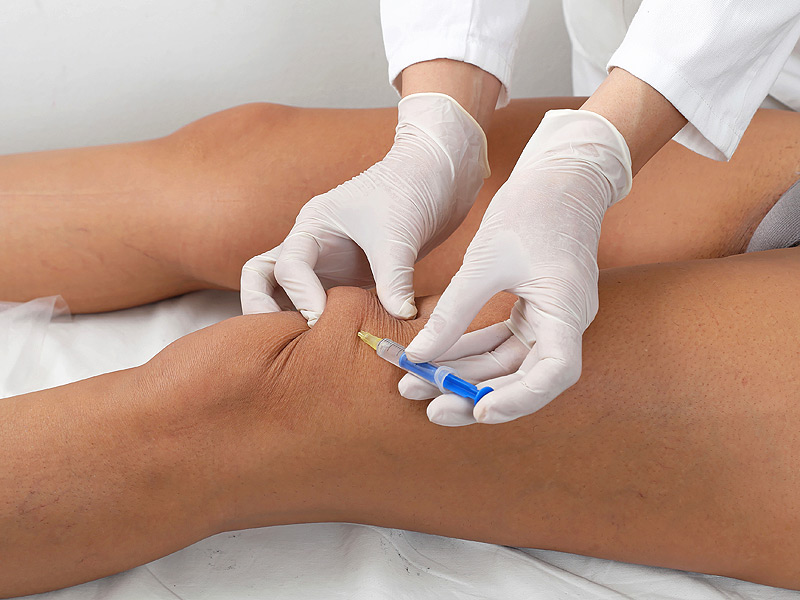
Therapy folk remedies less effective than medication, but widely used for orthopedic pain.
Basically, it includes external treatment on the leg:
- Dandelion, lilac and chestnut raw materials pour a glass of vodka and leave for 2 weeks. You need to moisten a piece of gauze in the infusion and apply lotions to the diseased area;
- From honey and mumiyo you can prepare an ointment that is rubbed on the side of the calyx and hamstring;
- A mixture of table salt, soda and mustard effectively removes swelling and reduces pain. Honey is also used as a base for the mixture.
If you don’t know the name of the place where you feel discomfort, go to an in-person appointment with a doctor.
If you feel heaviness, burning, the knee is swollen or pulling– it will be very difficult to find the reasons on your own. It happens that sharp knees are just a cosmetic feature, but it happens that the kneecap begins to hurt when pressed from the front and indicates pathology.
A small bruise at the bottom of the knee in children should not cause concern, even if it burns and bakes. If the lymph node is inflamed or the baby is pulsating above the popliteal fossa, there may be vascular pathologies.

